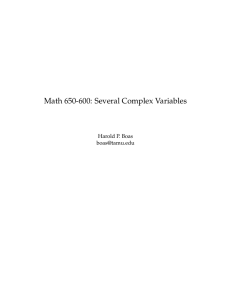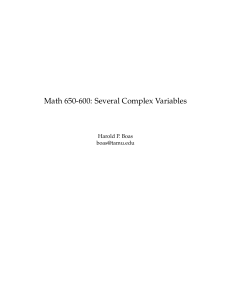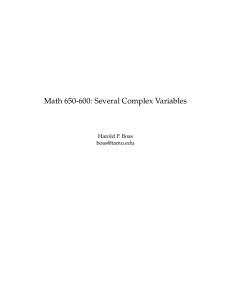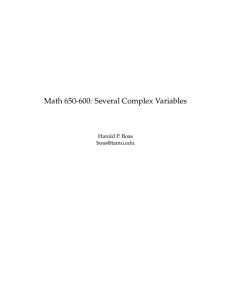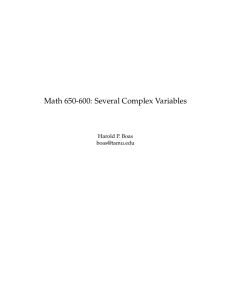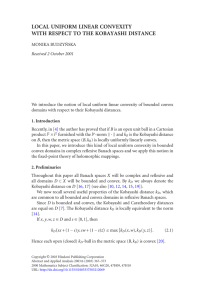Math 650-600: Several Complex Variables Harold P. Boas
advertisement
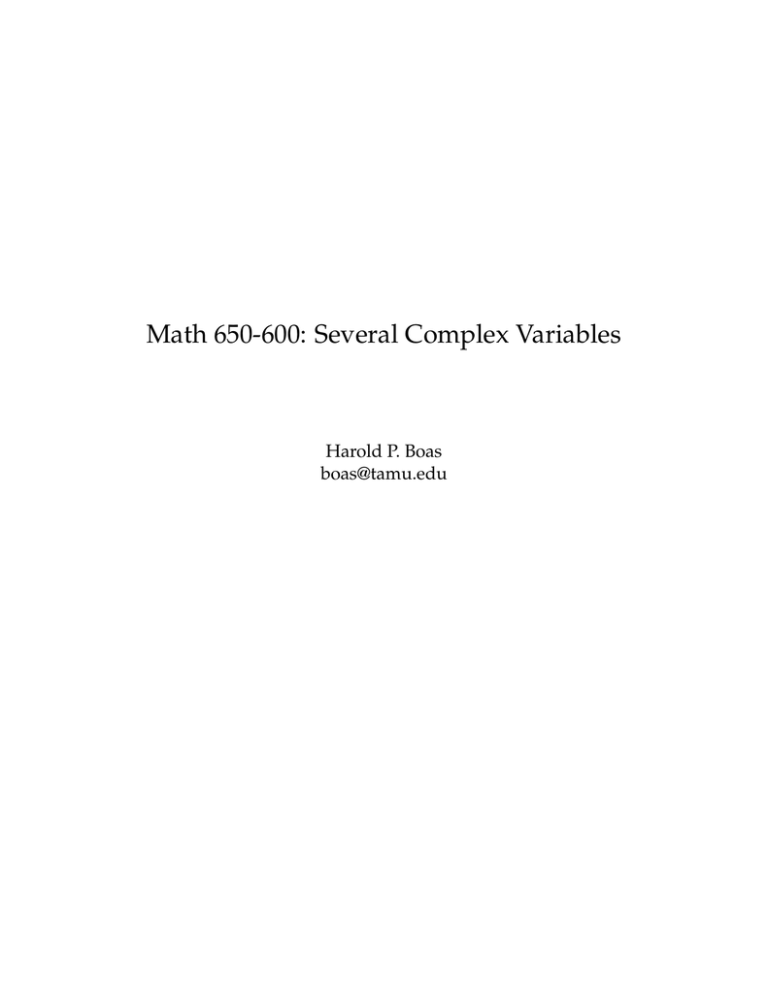
Math 650-600: Several Complex Variables
Harold P. Boas
boas@tamu.edu
Equivalence theorem from last time
Theorem. The following properties of a domain Ω in C n are equivalent.
1. Ω is a domain of holomorphy in the sense that for every point of bΩ there exists a holomorphic function on Ω that “does not extend across the boundary near p”.
b bΩ).
2. If K ⊂⊂ Ω, then dist(K, bΩ) = dist( K,
b ⊂⊂ Ω; in other words, Ω is holomorphically convex.
3. If K ⊂⊂ Ω, then K
4. Ω is a domain of holomorphy in the sense that there exists a holomorphic function on Ω
that “does not extend across any part of the boundary”.
Math 650-600
March 1, 2005 — slide #2
Exercise
A domain Ω in Cn is holomorphically convex if and only if for every sequence of points in Ω
with no accumulation point in Ω there is a holomorphic function on Ω that is unbounded on
the sequence.
Math 650-600
March 1, 2005 — slide #3
Monomial convexity
Theorem. The following properties of a domain Ω in C n are equivalent.
1. The domain Ω is convex with respect to the set {|z α | : α1 ≥ 0, . . . , αn ≥ 0} of moduli of
monomials.
2. The domain Ω is both a complete Reinhardt domain and a domain of holomorphy.
3. The domain Ω is a complete, logarithmically convex Reinhardt domain.
Thus for domains with a lot of symmetry, we have both a geometric characterization and a
function-theoretic characterization of what it means to be a domain of holomorphy.
Math 650-600
March 1, 2005 — slide #4
Proof
(1) ⇒ (2). Since the monomials are a subset of the holomorphic functions on Ω, monomial
convexity implies holomorphic convexity. So if Ω is convex with respect to the monomials,
then Ω is a domain of holomorphy.
Also, the monomial hull of a single point (w 1 , . . . , wn ) is the closed polydisc { (z1 , . . . , zn ) :
|z1 | ≤ |w1 |, . . . , |zn | ≤ |wn | }. So if Ω is convex with respect to the monomials, then Ω is a
complete Reinhardt domain.
(2) ⇒ (3). If Ω is a domain of holomorphy, then there is a holomorphic function on Ω that
cannot be extended to a larger domain. If Ω is a complete Reinhardt domain, then that holomorphic function has a power series expansion that converges in all of Ω. Consequently, Ω is
the convergence domain of some power series. We saw previously that convergence domains
are logarithmically convex.
Math 650-600
March 1, 2005 — slide #5
Proof (continued)
(3) ⇒ (1). Suppose Ω is a complete, logarithmically convex Reinhardt domain, and let K be
a compact subset of Ω. We need to show that the monomial hull of K is a relatively compact
subset of Ω.
We can cover K by a finite number of polydiscs whose closures are contained in Ω. Hence we
need only consider the case when K is a finite set S of points with no coordinate equal to 0.
If z is in the monomial hull of S, then |z α | ≤ maxw∈S |wα | for all α, and hence ∑nj=1
α
maxw∈S ∑nj=1 |α|j log |w j |.
∑nj=1 λ j log |z j | ≤ maxw∈S
αj
|α|
log |z j | ≤
Density of the rational numbers in the real numbers implies that
∑nj=1 λ j log |w j | for all non-negative real numbers λ 1 , . . . , λn such that
λ1 + · · · + λn = 1. The logarithmic convexity of Ω now implies that all such points z lie in a
compact subset of Ω.
Math 650-600
March 1, 2005 — slide #6
Set operations
Which of the following classes of domains
(a) convex domains, (b) domains of holomorphy, (c) polynomially convex domains, (d) monomially convex domains, (e) weakly linearly convex domains
are preserved under the following operations?
(i) taking Cartesian products
(ii) taking unions
Math 650-600
March 1, 2005 — slide #7
